51 Esti-Mysteries
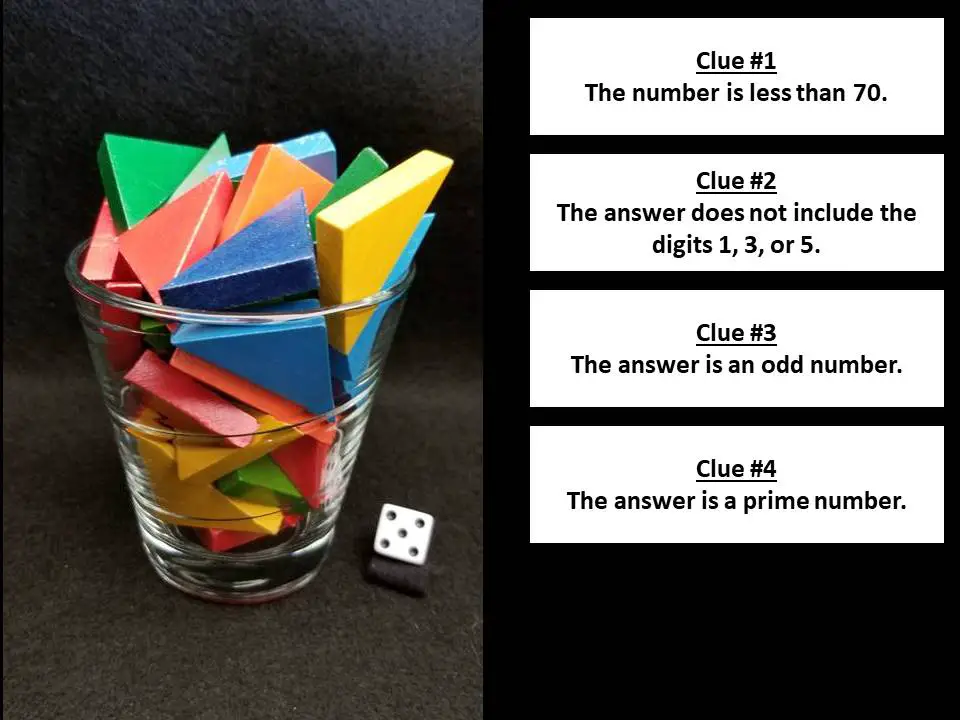
51 Brand New Esti-Mysteries! 4 Challenge Levels! All New Images!
If you’ve used the Esti-Mysteries from the original Esti-Mysteries blog post, or the 15 additional Esti-Mysteries that I wrote for 20 Days of Number Sense and Rich Math Talk, you’ll really enjoy this new set!
My goal was to write and post 51 brand new Esti-Mysteries between September and December.
The 51st Esti-Mystery was posted on Nov. 29, 2019.
After reading this blog post, take a look at THE 12 MOST POPULAR MATH STRATEGIES AND DOWNLOADS ON THIS BLOG.
How do Esti-Mysteries work?
If Esti-Mysteries are new to you, or if you have any questions about how to use Esti-Mysteries, please see the Q&A section below Level 500.
One other quick note.
Along the way, you’ll notice that I’ve also written a 2-hour course, called The Esti-Mystery Creator Course, that you are welcome to purchase if you’d like to have my tools and learn how to create your own Esti-Mysteries that are tailored specifically for your students. I’ve written quite a few Esti-Mysteries. There are about to be 51 new Esti-Mysteries posted here, so you may have plenty without ever taking the course. It’s a little tricky to keep up with all of the specific requests for Esti-Mysteries, so I wrote the course so that anyone who wants to learn how to make their own – tailored specifically for their students – will have all the resources to do so. If you are interested in learning how to write your own, you can find out more about the course here.
Also, if you would like to be notified when new Esti-Mysteries appear, please take a moment to subscribe to the blog.
Recommended: Here is a set of downloadable charts which students can annotate with each clue. Print out the charts and give each student their own copy of the chart. You’ll find 4 variations of the chart. Choose the ones that work for you and your students.
4 Printable Esti-Mystery Charts
51 Esti-Mysteries
Level 100 (Grades K-2)
Esti-Mystery 101 – “More Pieces Than You Can See”
Esti-Mystery 102 – “Shiny Rings”
Esti-Mystery 103 – “Bricks or Dominoes”
Esti-Mystery 104 – “Flying Cars K-2”
Esti-Mystery 105 – “Something Fishy”
Esti-Mystery 106 – “Red and Yellow”
Esti-Mystery 107 – “Bingo Lid”
Esti-Mystery 108 – “Two of Hearts”
Esti-Mystery 109 – “Brown Beads”
Esti-Mystery 110 – “Dominoes You See and Dominoes You Don’t”
Esti-Mystery 111 – “Block Talk, Level 1”
Esti-Mystery 112 – “Unleaded, Level 1”
Esti-Mystery 113 – “Gobs of Globes”
Esti-Mystery 114 – “Rocky Glass, Level 1”
Level 200 (Grades 1-3)
Esti-Mystery 201 – “Domino Dots”
Esti-Mystery 203 – “Lighter than Bricks”
Esti-Mystery 204 – “Length of Ribbon”
Esti-Mystery 205 – “Rocky Vase”
Esti-Mystery 206 – “The Return of the Rings”
Esti-Mystery 207 – “Block Talk, Level 2” (just updated)
Esti-Mystery 209 – “Unleaded, Level 2”
Esti-Mystery 210 – “Buttons Blue and Yellow, Too”
Esti-Mystery 211 – “Airplanes”
Esti-Mystery 212 – “Beads in a Bowl”
Esti-Mystery 213 – “Gobs of Globes, Level 2”
Level 300 (Grades 3-8)
Esti-Mystery 301 – “Not Carrot Sticks”
Esti-Mystery 302 – “Countdown”
Esti-Mystery 303 – “String Beads”
Esti-Mystery 304 – “Triangular Prisms”
Esti-Mystery 305 – “Three Containers of Dominoes”
Esti-Mystery 306 – “Flying Cars 3-8”
Esti-Mystery 307 – “Blue Rocks”
Esti-Mystery 308 – “Mirror, Mirror”
Esti-Mystery 309 – “Erasing Numbers”
Esti-Mystery 310 – “The Return of the Erasers!”
Esti-Mystery 311 – “Block Talk, Level 3”
Esti-Mystery 312 – “Yellow Hexagonal Prisms”
Esti-Mystery 313 – “Kazoom, Part 2”
Esti-Mystery 314 – “Rocky Glass, Level 3”
Esti-Mystery 315 – “Unleaded, Level 3”
Esti-Mystery 316 – “Gobs of Globs, Level 3”
Level 400 (Grades 3-12)
Esti-Mystery 401 – “Facing Prisms”
Esti-Mystery 402 – “Packing Peanuts”
Esti-Mystery 403 – “Advanced Bingo”
Esti-Mystery 404 – “Block Talk, Level 4”
Esti-Mystery 405 – “Prism Challenge”
Esti-Mystery 406 – “Where’s the Graphite?”
Esti-Mystery 407 – “Rocky Vase, Level 4”
Esti-Mystery 408 – “3 Gobs of Globes”
Q & A
The 5 Most Frequently Asked Esti-Mysteries Questions I Receive
I love the questions, so please keep them coming!
Q1. How do I get the Esti-Mysteries?
A1 Simply click on the hyperlinked titles above. When you do, you may see the PPT file download to your computer. If you don’t see it, check your download folder.
Q2. The Esti-Mysteries are PowerPoint files, but I use Google Slides. What do I do?
A2 Just save the PowerPoint file in your google drive. Then open it with google slides. I’ve used only animations that will work in both platforms, so once you open it with google slides, it will be completely ready.
Q3. How do I use the Esti-Mystery?
A3. I’ve made the Esti-Mysteries as user-friendly as possible. When you have the file on your computer, simply open it and play the slide show (you’ll see why that is so important in the next answer) and follow the directions on the screen.
Q4. When I come to The Reveal (shown below) I can’t find the answer. How do I get The Reveal to show the answer?
A4. Great question, and there is a really quick solution. When you use the Esti-Mysteries, simply make sure the slide show is playing in its presentation mode. For example, in PowerPoint, be sure to click on SLIDE SHOW then FROM BEGINNING. If you are using Google Slides, click on VIEW then PRESENT.
When the slide show is playing, all of the animations will work as expected. One of the key animations is that The Reveal box disappears and shows the answer which is beneath it. If the slide show isn’t playing, the disappear animation won’t be activated. The reason I’ve placed each answer beneath the reveal box is so that students won’t accidentally see it when you are opening up the file.
Q5. How can I show the clues one at a time – instead of all at once?
A5. This is actually the same answer as A1 above. If all of clues are appearing at once, then the slide show isn’t playing. Just follow the directions above and they will appear one at a time.
Q6. Should the students use charts?
A6. Yes. In almost every case*, I recommend that students should use a chart, write on the chart to cross out numbers that have been eliminated by the clues – or circle the ones that remain as possibilities – and continue to estimate and discuss their reasoning after each clue.
*There are some Esti-Mysteries, particularly in Level 300, Level 400, and Level 500 that require strategies that are more advanced than the use of the chart and/or are beyond the range of the chart. In those cases, I recommend that students use the strategies that will be more effective, but I won’t include any spoilers here. 🙂
Q7. What about whiteboards? Can the students simply write their answer on whiteboards without using the charts?
A7. For many other activities, I really like the use of individual whiteboards. For example, The Estimation Clipboard is a great activity for individual whiteboards on their own. However, for Esti-Mysteries, if that is the only tool that students are using – without an accompanying chart, then many of the Esti-Mysteries will become confusing for students. Follow the example below, and you’ll see exactly what I mean.
Below are the clues from the Esti-Mystery that is on my desktop right now. Let me briefly take you through a journey that 2 students might experience. Student 1 (with the chart) and Student 2 (without a chart)…
Before the first clue appears, both students select an estimate and then explain what number they chose and why they chose it. They are likely both pointing to the picture as they explain their reasoning. Let’s see what might happen after each clue appears to compare the experiences of these 2 students.
Student 1: Using their chart, circles all of the multiples of 3, from 3 through 51. (Notice that that experience is a useful practice in becoming familiar with the patterns and the multiples, and it allows the visual patterns on the chart to appear in a really interesting way.)
3, 6, 9, 12, 15, 18, 21, 24, 27, 30, 33, 36, 39, 42, 45, 48, 51.
Student 1 looks at the list of multiples, looks at the image again, considers which of the numbers still on the list appears to be the most reasonable estimate. Then the student chooses an estimate and explains what multiple they chose – and why they chose that number.
Student 2: Thinks about a multiple of 3 that seems like a reasonable estimate and writes it on their whiteboard (or blank piece of paper) and explains what multiple they chose as their estimate – and why they chose that number. (The estimate was 21)
Then clue #2 appears…
Student 1: Using their chart, eliminates all of the multiples of 3 (between 3 and 51) that include the digit 1.
3, 6, 9, 12, 15, 18, 21, 24, 27, 30, 33, 36, 39, 42, 45, 48, 51Student A considers the remaining possibilities, returns to estimation based on the remaining numbers and the image.
Student 2: Needs to write a new estimate. Thinks about what number is a multiple of 3, but does not include the digit 1. Thinks of a number that fits with both of those clues, and uses that number because it works – instead of truly revisiting the image and returning to estimation. (The new estimate is 33.)
Then clue #3 appears…
Student 1: Using their chart, eliminates all the remaining numbers that include the digit 4.
3, 6, 9, 12, 15, 18, 21, 24, 27, 30, 33, 36, 39, 42, 45, 48, 51It takes about 10 seconds to do.
Student A considers the remaining possibilities, revisits the image, and focuses on which of the remaining numbers is the most reasonable. Student A compares the image to the numbers and selects another estimate, and then explains to a partner what number they have now chosen – and why.
Student 2: Let’s say this time that the estimate that student 2 chose still works, so the student does not change the estimate. (The estimate remains at 33.)
Then the next clue appears…
Student 1: Quickly eliminates 3, 6, and 9 (because they are one-digit numbers) and 33 (because it does not include 2 different digits)
3, 6, 9, 12, 15, 18, 21, 24, 27, 30, 33, 36, 39, 42, 45, 48, 51
Student A considers the remaining possibilities, the image, and focuses on which number is the most reasonable.
Student 2: Recognizes that 33 doesn’t work and needs a new estimate. However, the student now needs to think back through all the layers of clues and try to think of a number that matches all 4 clues. Student 2 is focusing on going back to find a number (possibly any number) that matches the clues…
Student 1 is focusing on the most reasonable estimate…
Student 2 is trying to hurry to find a number that matches the clues rather than focusing on estimation. Student 2 settles on 30 because it matches the clues NOT because of that seems like the most reasonable estimate. Notice that student 2 hasn’t actually engaged with estimation or the concept of 2-digit numbers and doesn’t have solid estimation reasoning to discuss.
Then clue #5 appears…
Student 1: Quickly eliminates 30 and 36 on the chart (because they even numbers)
3, 6, 9, 12, 15, 18, 21, 24, 27, 30, 33, 36, 39, 42, 45, 48, 51
Student A now knows that the answer is either 27 or 39, and focuses on which of those is the most reasonable. This student is revisiting the picture, estimating, considering reasonableness, and discussing their ideas and hearing the ideas of others. An important note here is that the other students or students in the conversation are also discussing 27 and 39, so they can have a rich conversation about reasonableness, the image, and those 2 specific numbers.
Student 2: Needs to choose a new estimate. So this student tries to think of a number that is an odd number… and includes 2 different digits… and does not include the digit 4 or the digit 1… and is a multiple of 3. This student is not able to focus on estimation or reasonableness. Instead the student is simply trying to find a number that works.
Worth noting: There are some ways that a whiteboard on its own could be used effectively for this particular Esti-Mystery. For example, I used a list rather than a chart as context for the comparison above. Lists can work well when the sets are fairly small. However, when the first clue is “The answer is an odd number between 1 and 100,” the use of a list is far less practical.
In the end, I recommend providing each student with a chart to use.
Q8. Can I send you a specific math concept and have you write an Esti-Mystery around that concept?
A8. I typically do my best to respond to requests like this. However, since the school year becomes so very busy for all of us, and since there can be so many requests all at once, I realized that it would be better to write The Esti-Mystery Creator Course so that anyone who is interested in learning how to create Esti-Mysteries precisely for what their students are working on at any given time will be able to do so.
Q9. Some of the Esti-Mysteries have charts on them. Why is that?
A9. I typically include charts on the first few Esti-Mysteries of new sets to help students see how they might use a chart when they solve the Esti-Mysteries.
Q10. What is your biggest tip for using Esti-Mysteries?
A10. Make sure your students write down their estimate at the beginning AND after each clue. Most importantly, be sure that each time a new clue appears that students have a chance to discuss the clue, write down their new estimate, and explain to each other WHY they chose that estimate.
I truly hope you enjoy the 51 new Esti-Mysteries!
Thanks for visiting my blog!
All my best,
Steve
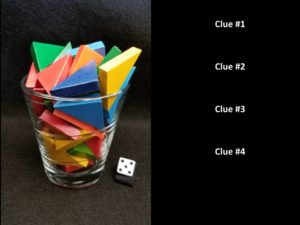
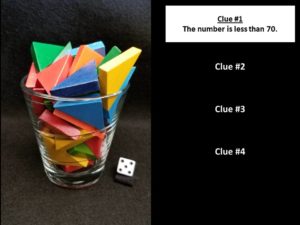
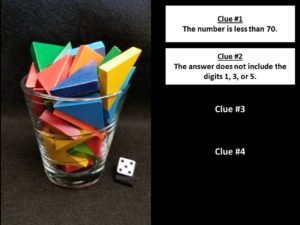
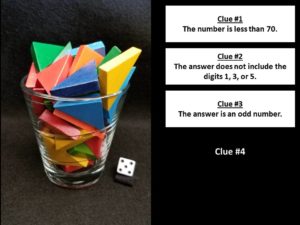
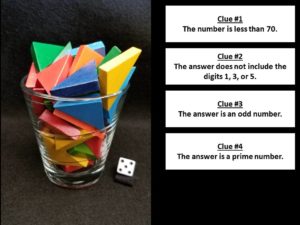







Hi Steve,
I wrote you a message a few days ago thanking you for thses amazing resources.
I didn’t realize that my comment would/might be published online, so for privacy, please remove my last name from my post before you put it up.
Thanks again….Your resources are making my year!
Lisa A
Hi! We love your esti-mysteries. Where can I find your estimysteries that have just pictures and no written clues? They are perfect for our ELL students. Thank you!
Hi, Heather. Here are the latest ones: https://stevewyborney.com/2021/10/new-estimation-clipboards/
These are amazing! I love how they come pre-made on a powerpoint! I appreciate all the time and effort it took to put these together.
Thanks so much!
Hi, Kay. I really appreciate the comment. You are welcome.
Hi Steve, Just had Math PD and your awesome website was chatted about! So great!… but for some reason any of the mysteries that I click on just go to a grey page on my chromebook, I even checked in my downloads and nothing? I also tried copying the link and pasting it in the url, but only a grey page pops open? Has anyone else had this issue?
Hi, Alexa. I think the best thing to do is to download it on a PC, save it into your google drive, then from your chromebook open the file from google drive and present it from there.
Steve,
Have you ever had a teacher have their class create their own esti-mysteries? The week before winter break, I was thinking of having the kids work in groups and create their own to share with the class. I was wondering if anyone else had done this?
Hi, Tiffany. I lot of classes have done this. It’s a very rich and challenging process and I think your students would really enjoy it. Allow several days to to the creating of the image, and then the clues, and then trying it out, and finally presenting it to others.
My students LOVE Esti-Mysteries! Yesterday when we were doing one, one of my students asked where I got them. I explained, and he wanted to know if I was stealing them. I said, “No, he is kind enough to share them with us.” He then commented that you must be a “REALLY nice man!”
So thank-you for being a REALLY nice man, and making mathematical thinking fun for my students! 🙂
I’m so happy to hear these kind words. It is my pleasure to make the and to give them away to other educators to use with their students. Have a wonderful week!
We LOVE Estimysteries! I am using them school-wide, K-5. Thank you for sharing all of your amazing resources.
Thanks, Sue! I am so happy to hear this. You may also be interested to know that some brand new ones are coming soon!
Thank you so much for sharing your amazing resources with us! This is so appreciated!!
Hi, Jessica. I’m catching up on blog comments with much appreciation. Thank you for taking time to leave a comment here. I’m so glad it is helpful.
Hi Steve,
Esti-mystery 51.3 Three containers of dominoes. I got 75 as an answer. 30 in each larger glass, (even) 15 in the smaller (odd/ half of 30). Am I missing something or is there more than one answer?
Thank you so much for sharing these! My class loves them.
Great question. There is always just one answer – but there are always about 2 or 3 reasonable choices to choose from. You have found one of those choices, but in this case the answer is 95. The containers have 38, 19, and 38 in the. Thank you for reaching out with this comment!
Me and my students were trying to find the answer but we couldn’t find it so do you think you can tell me the answer so i can help out my kids A little more
Hi, Jessica. The answer to the Esti-Mysteries is always under the red box that says “The Reveal.” Make sure the slide show is playing so that the animation (that makes that box disappear – and shows the answer underneath it) will work. In a pinch, if it doesn’t work for some reason, just slide the box away (you can only do that when it’s not playing) and you will see the answer underneath it.
These esti-mystery tasks have become a new favorite for me and my 6th grade/7th grade math students as we’re are navigating online learning! I was looking for some math routines that would be approachable for a variety of learners and also engaging enough to keep them involved while away from my classroom and these have done that!
I’m so happy they have been helpful and fun!
My students LOVE these and beg for them every day. I teach 4th grade, as well as advanced math enrichment for 2nd, 3rd, and 5th. And every day, it’s, “Can we do Esti-Mysteries today?” I am psyched for this set…my only wish is that it was zipped up so I wouldn’t have to download them one at a time 😉 #firstworldproblems ! And you’ve provided #firstrateproblems so I can’t really complain.
Hi Steve,
We started using esti-mysteries last fall and the students loved it. I’ve been struggling to teach inquiry math (we’re an IB school) in the online learning program we are doing during Covid-19. So we do more traditional math during the week, but Friday is Challenge Math. We’ve been doing logic puzzles, area mazes, Splat routines and… everybody’s favorite- Esti-mysteries. They are so popular students and a teacher from another grade level have joined. I use Teams. Unfortunately, they don’t have the student forms, but I have them write down their answers on paper.
I am just a huge fan of your site. Next year, I am slated to host a PLC on inquiry math. I plan to share all of the wonderful resources you have posted here. You have my very sincere thanks for these amazing resources.
My goal is to get the students creating their own esti-mysteries. Do you have a collection of student or teacher-created esti-mysteries that have been shared with you? I’d love to look at them with the students.
Many thanks and appreciations!
Ms. Duncan
XIS International School, China
I don’t have a collection of student-created or teacher-created Esti-Mysteries. That would be really fun to see, though!
About Esti-Mystery 402 “Packing Peanuts” Using the given clues and algebraic formulas we arrived at 5 potential solutions, one of them being the solution you have. The possibilities we found are 26, 32, 38, 68, and 86. Can you shed some light on your solution.
Hi, David. I’m catching up on comments. All of the numbers you found do fit the clues. In this one you can count right around 38 foam pieces that are visible and, of course, there are many more that can’t be seen. So the conversation should come down to 68 or 86. Every Esti-Mystery has at least 2 (sometimes 3) reasonable answers and ends up with a discussion and a final estimate before the reveal. In this case there are 68. I love that you created algebraic formulas!
With your first esti-mysteries, you made available a list of the clues without the images so one could look at specific skills. Have you done that for the 51 mysteries that you’ve now added or am I just missing it?
My 6th grade math classes are loving the estimysteries. In fact, I’ve had to begin rewriting the clues to some of the small number mysteries because we’ve run out of puzzles to do. Here are my new clues for “Something Fishy”.
1) The answer is between 10 and 31. Write a list of possible answers.
2) The answer is not a square number.
3) The answer is not a multiple of 3.
4) The answer is not a prime number.
5) The answer does not contain the digits 4 or 8.
I like what you’ve done! This makes me wonder if I should write more of them. Have you tried the 15 Esti-Mysteries inside 20 Days of Numbers Sense and Rich Math Talk?
Hi, Steve,
All of your work is well-loved by my students (gr. 1-8)–and me! Just can’t get enough!
I did find an error in the Facing Prisms Esti-mystery. There are 6 faces and 6 vertices on the prisms, so those two clues cancel each other out. The 100 chart after the 6 faces clue doesn’t have the 12, 36, 72, and 96 crossed out.
You know the kids are thinking critically when they spot this! Thanks so much for all your work!! AH
Hi, Anne. What a great question! This is one of the esti-mysteries when not all of the faces (or vertices) of the prisms can be seen. So, on the prisms even though you can’t see 6 vertices, the students can work out that a triangular prism have 6 vertices. Then with the final clue, they see that the answer is a multiple of 6, which brings the possible numbers down to the set that you mentioned in your comment. This might be a fun one for your students to revisit in that new light. Enjoy, and thanks for reaching out with this great question!
Steve,
We’re loving the Esti-Mysteries we’ve been solving each week. We did find a typo in the Red and Yellow mystery. In most of your sets you use the words “cross out”, but in this one, clues 2, 3, and 4 say “cross of.” I think you meant cross off. You can thank my second graders for catching this. I didn’t even notice.
Thanks so much for sharing all of these. It’s clear that my kiddos are already improving in their estimation skills as we walk through these mysteries together.
What a great catch! Thank you so much. I just updated it so that it reads “cross off” on both of those clues. Please let your students know how impressed I am. Not only are they great mathematicians, but they are also wonderful editors. Well done!
Steve; I am doing esti-mysteries with a 5th grade class each Wednesday. Today we worked on “Three Containers of Dominoes” We got it down to 75 or 105. We could not get 95 to work, even though that is the answer! Can you give us some clues to think about that will help?
Hi, Lisa. This may help: Which clue in 3 containers of dominoes eliminated the 95?
You may also want to make a list of numbers (60 and greater) and cross off the numbers that are eliminated by the clues as you go.
Let me know if that helps.
We are curious about the dice we see outside of the container. Is their a purpose?
Great question. Every now and then I incorporate the die into a clue. I’ve learned not to do that every time or else students begin to look there first, instead of estimating first. It also gives me options as a clue writer, and it serves as a size reference to add context for students.
Steve, some second graders and I were confused by the clues in brown beads. We narrowed the choices down to 11-19 after the more than 10 and less than 20 clues, but then the next clue said the number does NOT contain the digits 1, 2, and 3. That eliminates everything! Led to a nice discussion about place value (and that the ones place did not contain a 1, 2, or 3) though.
Great question! I made a mistake and rewrote that clue. I had intended the 1 to only eliminate digits in the ones place. If you download the new version, you’ll see how I changed that clue so that it no longer eliminates numbers with the digit 1. Thanks for sending that my way!
Re: Brown Beads
What number over 10 and under 20 does not include the digit 1? Did you mean “does not end in …”
Yes, I originally meant does not have a 1, 2, or 3 in the ones place. I just posted a new version so that clue now only reads that the answer does not include the digit 2 or 3. You can download the updated version now.
Sometimes the entire clue doesn’t show up… Am I doing something wrong? I’m using powerpoint.
Thanks so much!
I’m not entirely sure, but I wonder if it might be show in “widescreen” format. I wonder if adjusting the size of the display might help.
I’m a STEM teacher and I’ve shared these as a class warm up so far with my second and third graders. They LOVED them! It was so fun to have them explain their reasoning for their estimate. The only thing we wished was after the answer is revealed we could see the items laid out., similar to a Three Act Task. We have done counting collections before and are surprised sometimes just what a number actually looks like. Some of my third graders still can’t believe the answer to “Flying Cars”. We hope to do many more this year!
Hi, Julie. I find that many people often estimate about 1/3 lower than the actual total. That’s been really interesting to observe in both others and myself. I had considered additional pictures, or even videos, to show the objects all being laid out, but I could tell it was going to turn into a very slow process, so I didn’t go that way. I do very much love how the 3-act tasks include that as a feature!
I can’t wait to try this. Thank you!
Steve–Can’t thank you enough for this incredible food for math thought–my students beg for esti-mysteries. To save paper, we use this digital one hundred chart on our chrome books: https://toytheater.com/hundreds-chart/ It seems to elevate the fun even more!
Thank you for sharing the digital chart! We don’t have a printer at home, and now I don’t have to bother my husband to print the chart for me. 🙂
Was it 47? Where can I see the answer?
I’m confused as to where I can fidn the answer to the pattern blocks one which is the first one I did with my kids to try out… 🙁 Please help!
Hi Steph. To make the answer appear, make sure the slide show is playing (slide show, view in PPT or Present in Google slides)
Steve, thank you so much for making the Flying cars fun for my first graders!! We have 4 students who think there are 18, 8 who think there are 36, and 9 who think there are 48.
Thank you for this awesome resource. My students beg to do them. I hope this is the right place to post this answer for Flying Cars. My students decided it was 36 cars. They had chosen a smaller range than 61 before revealing the first clue, they argued their thinking so we stuck with it. I’m having a little trouble getting this posted….saying I have duplicate posts?
Thank you for this awesome resource. My students beg to do them. I hope this is the right place to post this answer for Flying Cars. My students decided it was 36 cars. They had chosen a smaller range than 61 before revealing the first clue, they argued their thinking so we stuck with it.
Hi Steve – my class loves the Esti-mysteries! They beg me to put one on everyday! So thanks so much for contributing to my class on a daily basis!
For the Flying Cars, our Gr 4/5 class has chosen two answers – 36 or 48. They are excited to see who is right!
Consensus from the fourth grade at Wolfsville Elem. in Maryland seems to be 36 for the flying cars mystery. A few are still holding on to 48, but we don’t think that’s as reasonable.
I am new to esti-mysteries but really want to use them in my classroom. What is the best way to download them? I tried the download PDF option and it didn’t work. Thank you
Hi, Kristy. Just click directly on the blue link and it will download. You may need to check your download folder to find it. Have a great day!
Thank you so much! These are wonderful. May i ask you if you can get more than one answer per question? Thank you
Hi, Paula. There is always just one answer for each Esti-Mystery question. However, the clues do not narrow it down to only one answer. The clues normally narrow down the options to 2 or 3 possibilities, and then the students can decide which of those remaining possibilities is the most reasonable. Then the reveal will show the actual number of objects. The reason for this is that if it I eliminated all of the numbers except for 1, then there would be no need to estimate at the end, and there wouldn’t be any mystery left. The conversation about which of the remaining numbers is the most reasonable at the end is one of the most important discussions. Great question!
My students love these activities! Thank you so much for providing them to us!!!!
Thanks, Alison! I really appreciate it. I’ll be posting quite a few more over the next several weeks.
I can only download the first two mysteries for each level. Is there a way to download the rest?
Hi, Jessica. I’m posting some each week. I’ve planned to post one from each level each week, but I’m moving a little more quickly than that. I just need a big, open block of time. 🙂
Awesome! Thank you so much!
I’m so happy the share, and I appreciate the comment!
My 5th graders love these and our entire school is all about number talks. Thank you so much for creating these and providing them to math learners everywhere!!
These are great! Thank you so much!! I look forward to using them with my gifted elementary students.
I am so excited to try these I love the concept and think they will work amazingly with my resource room students. I have tried other types but they were not as successful.
Wow, Steve, we are already converts in Rm 20 – a bunch of crazy 10 year olds in Auckland New Zealand who rise to every challenge – so sharing this resource is not only exceptionally generous of you, but consolidates our love of all things mathematical. Many many thanks!